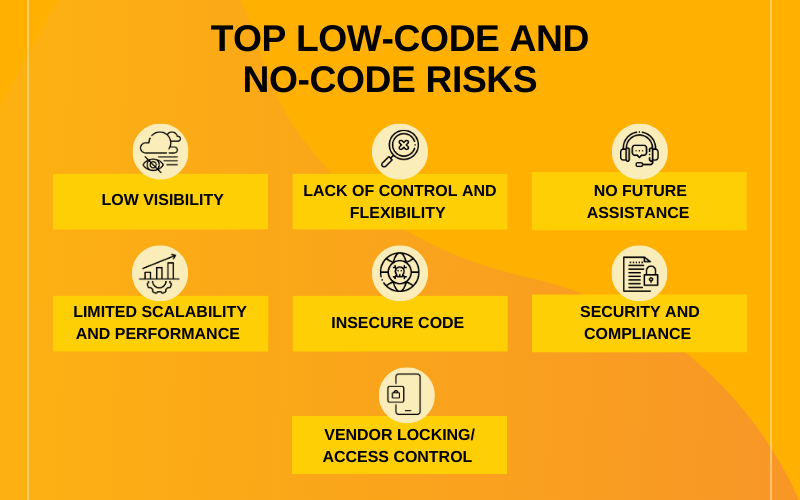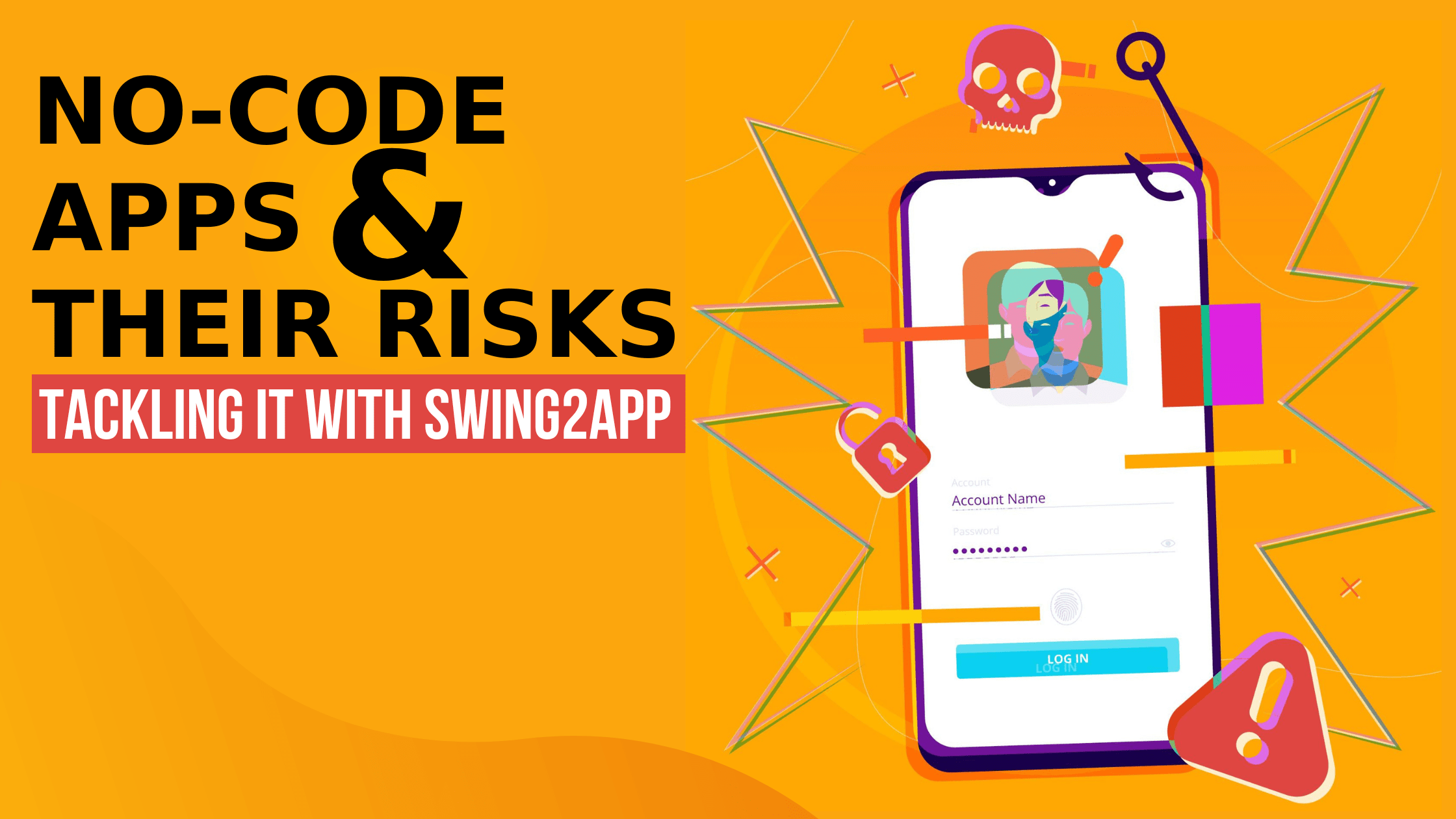No-Code platforms provide a powerful tool for developing custom application software without writing any code. The software development industry is evolving. While we create increasingly complex and responsive applications, the software development process is becoming more simplified.
Today, non-professional software developers known as citizen developers—those without formal education in the field and with limited knowledge and skills—can build platforms for their clients’ external business operations.
This is primarily due to low-code and no-code platforms, which enable citizen developers to create applications without writing a single line of code.
However, as with any technology, No-Code platforms have risks and challenges that must be addressed. The so-called low-code and no-code movements have raised some security concerns, even as cyber threats become more numerous and dangerous. We will look at some of the risks associated with No-Code platforms and how Swing2App addresses them in this blog post.
WHAT IS NO-CODE SOFTWARE DEVELOPMENT?
As previously stated, no-code software development does not actually require the software developer manually write code in one or more programming languages, line by line. Low-code app development includes no-code development tools that allow you to create parts of your software without writing code, but there will always be aspects that require manual programming.
Coding is never required with no code. Without writing a single line of code, you can create applications from scratch that are fully functional and ready for launch. Of course, this does not imply that code magically disappears from the software development process, but rather that your no-code development platform generates it automatically.
It’s important to think about the risks of no-code since it might seem that you don’t really have full control over your code with no-code development platforms and because citizen developers are less knowledgeable than professional developers when it comes to security risks, the protection of sensitive data, and other security implications.
TOP LOW-CODE AND NO-CODE RISKS

Risk #1: Low visibility
It is truly the case that developers have access to the source code through no-code development platforms. However, unlike traditional software development, the code itself, which can be quite large, is not as visible to both developers and clients.
Users of no-code platforms cannot easily see or inspect the code, which can have the following consequences:
When a company gets software from no-code development platforms, it wants to see the security controls and code that are in place.
When a team uses a no-code platform, the single developer or lead engineer cannot have a code vision that allows them to clearly understand the relationship between the various components (different modules, plugins.)
Access control is restricted, leaving low-code or no-code software vulnerable.
However, even with traditional development, projects typically have a large code base: many components, various modules, and plugins. There are almost no solutions for the developers or CTO/lead engineer to see all the relationships in the project from above.
Risk #2: Lack of Control and Flexibility
The lack of control and flexibility is among the main risks of No-Code platforms. Users might not have full authority over the layout, design, and functionality of their applications because No-Code development platforms use pre-built features and templates. This can be a problem for organizations that require highly customized solutions to meet their unique needs and specifications.
Swing2App addresses this risk by providing a variety of advanced tools and features that give users greater flexibility and control over their applications. Swing2App allows users to build apps from the scratch up by clicking and selecting feature menus and options. This enables users to create applications that are customized to meet their particular needs and requirements, all while maintaining control and flexibility.
Risk #2: Limited Scalability and Performance
Another risk associated with No-Code platforms is the chance of limited performance and scalability. Because No-Code platforms are intended to be simple and easy to use, they may not always be capable of handling large amounts of data or complex processes. This can be a problem for organizations that rely on their applications for high performance and scalability.
Swing2App addresses this risk by providing a variety of tools and features that guarantee maximum performance and scalability. Swing2App allows users to create no-code apps as well as launch them quickly in order to increase conversion rates, meet user needs, meet market expectations, and optimize business operations. As a result, your app is scalable.
Risk #3: Security and Compliance
Another risk associated with No-Code platforms is the possibility of security and compliance issues. Because No-Code development platforms are intended to be user-friendly and simple to use, they may not always provide the same degree of safety and compliance as traditional software development processes. This can be a problem for organizations that must adhere to strict security and compliance standards, such as financial institutions and healthcare facilities.
Swing2App addresses this risk by ensuring security and compliance. Swing2App includes advanced security features like support for compliance standards like iOS and Android Appstore latest guidelines. Swing2App also provides regular updates to keep applications secure and compliant over time.
Risk #4: Vendor Locking/ Access control
Another risk of No-Code platforms is the possibility of security and compliance issues. Because No-Code development platforms are intended to be user-friendly and simple to use, they may not always provide the same degree of safety and compliance as traditional software development processes. This can be a problem for organizations that must adhere to strict security and compliance standards, such as financial institutions and healthcare facilities.
To address this risk, Swing2App supports multi-platform app creation. You just need to create one app and it can be uploaded to both iOS as well as Android platforms. Thus, you won’t have to worry about shifting your code to another platform.
Risk #5: No future assistance
Another risk of No-Code platforms is the possibility of app maintenance and updates are not provided by every no-code app development platform. This can be a huge issue for citizen developers who don’t know how to keep their apps well up to date.
Swing2App helps you with this, you can get future assistance too. Both future app maintenance as well as updates are managed by Swing2App as per the latest guidelines.
Risk #6: Insecure code
The safety of the code is heavily dependent on its quality and the level of developers. Even if the developers are at the highest level, they make human errors – they forgot there, they missed it here. Unlike people, the no-code platform Swing2App never makes mistakes and always follows instructions, follows best practices, and does not forget anything.
For a variety of reasons, using no-code platforms like Swing2App is more secure than traditional development methods.
First and foremost, no-code platforms are built on best practices, ensuring that all code is properly written and error-free.
Second, no-code platforms are intended to automate as many tasks as possible, reducing the possibility of human error.
Finally, no-code platforms are constantly updated with the most up-to-date security features, shielding your code from ever-changing threats. To summarise, using a no-code platform provides a significantly more secure development than traditional approaches.
HOW TO REDUCE SOFTWARE SECURITY RISKS?
Now that we’ve discussed each security risk, we can move on to discussing the best security practices for mitigating them and elevating citizen development to the level of traditional software development.
Security testing
Security testing remains a key component of best security practices because it reduces the risk of insecure code. As an app developer, you should perform security tests on a regular basis. As a client (perhaps you’ve employed a low-code or no-code developer), you could perhaps request security scanning to ensure that insecure code is not replicated throughout the code.
Choosing the right tool
When you use premium no-code tools, such as Swing2App, which we recommend, the code generated automatically is of high quality. As you may be aware, the quality of the code has an important impact in terms of both security and performance.
With no-code development platforms like Swing2App, you eliminate the possibility of human error (no matter their skill set, developers can still forget details, miss some aspects, get distracted, and make small mistakes). Swing2App, on the other hand, generates code based on instructions and security best practices.
CHOOSING THE RIGHT NO-CODE DEVELOPMENT PLATFORM: CHOOSE SWING2APP
As we saw in the preceding paragraph, selecting the right no-code development platform is critical in terms of security implications. As a result, it is critical to recommend the best no-code platform available today – Swing2App. Swing2App is a platform that requires no coding. A no-code development platform differs from a low-code platform in that it does not require any manual coding. It comes with a visual interface and pre-built software blocks that you can assemble using a drag-and-drop system.

The code is generated automatically in the background (you can have access to it at any time). Swing2App is the best no-code development platform on the market because of the following reasons:
- Swing2App’s code is error-free.
- It is produced in accordance with the best security practices and ensures high levels of security.
- Swing2App automatically generates technical documentation in addition to code. Furthermore, because Swing2App can be configured component by component up to the maximum atomicity of access control, all accesses and changes are logged, improving software security from an access control standpoint.
- Swing2App can help you reduce the potential security risks of your no-code software while also making the software development process more efficient and time-consuming.
- Furthermore, you get much more flexibility and less complexity with Swing2App, which traditional coding can’t provide. Swing2App is a one-point solution for all app developers, especially for efficient, functional, and secure apps for small businesses.
CONCLUSION
To summarise, in order to survive in this highly competitive market and overcome actual problems in mobile app development challenges, a great deal of attention must be paid to the mobile app development process steps. In other words, you must ensure that you are producing quality apps capable of achieving great success and providing mobile app development solutions.
As a company decision maker, you must strive for success by overcoming the risks associated. If you want to expand and establish yourself as a firm, test your limits and stick to a plan. Unless the app development challenges are properly solved, the overall popularity of the application will suffer.
Furthermore, if you are a startup and mobility is on your priority list, you only need that initial boost to get started. Swing2App creates top quality professional mobile applications and can make your aspirations a reality.
